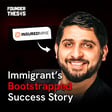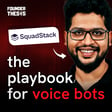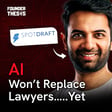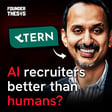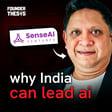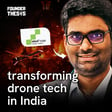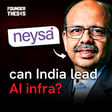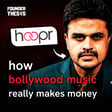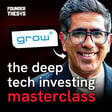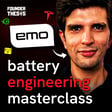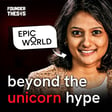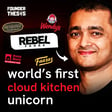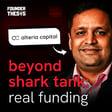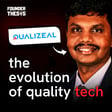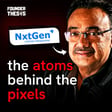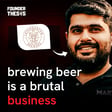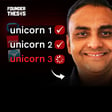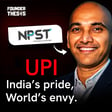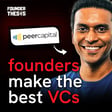Introduction to Gaurav Khatri and Noise
00:00:00
Speaker
Hi, this is Gaurav Khatri, co-founder of NICE.
India's Smartwatch Market Leadership
00:00:15
Speaker
you know which country is the biggest market for smartwatches in the world? If you guessed US or China, then you are wrong. In Q3 of 2022, India was the largest smartwatch market in the world.
Noise's Strategy and Market Dominance
00:00:27
Speaker
And in this episode of the Founder Thesis Podcast, your host Akshay Dutt is talking with Gaurav Khatri, the founder of the largest smartwatch company in India, Noyce.
00:00:36
Speaker
India's massive smartwatch market is a result of innovative work done by companies like Noise, which are creating a truly made-for-India product that is a perfect mix of the right features and right pricing.
Growth Without Investor Funding
00:00:47
Speaker
The most amazing thing about Noise is that unlike other large T2C startups in the consumer electronics industry, Noise has never raised any funds from investors.
Evolution from Smartphone Covers to Tech Leadership
00:00:56
Speaker
In this conversation, Gaurav talks about the journey of starting noise by selling smartphone covers on e-commerce websites and the many ups and downs in their journey before reaching to a stage where they are doing almost 2,000 crore of annual revenue today. Stay tuned and subscribe to the Founder Thesis Podcast on any audio streaming app to learn about the scaling up of your business without having to dilute your equity.
E-commerce Trends and Initial Online Steps
00:01:26
Speaker
So I remember reaching out to him and telling him that this is what I feel, e-commerce is booming. And we are people who are more influenced towards the internet. And I'm very sure if I am the person who is very convinced with buying things online, nobody will buy online. And he's also a very extremely fast forward guy. He will attempt for things very quickly, other than technology mature and then people using it.
00:01:54
Speaker
He was a person very early, like me. I told him, I really want to do something online and it's not very costly at this point in time. He said, if you want to do it, you have the opportunity. Why don't you start exploring things? From here only, why do you want to start from scratch?
00:02:13
Speaker
I think cool. So again, yeah, did not have enough money to probably directly start buying the gadgets.
Early Success with Smartphone Accessories
00:02:20
Speaker
Start, let's start experimenting in a way that, so the consumer is looking for this, the young consumer is looking for this.
00:02:30
Speaker
Is it really looking for this? And that's what when all the entire womb of the Chinese mobile phone brands were coming and the Xiaomi was coming and then making a very big impact on online business. The card was selling in one minute deal, selling in lakhs of phones. So, I realized here, they were very low online. And if one of 40,000 or 20,000 rupees can sell, why can't we start selling the accessories around it first? Let's understand it.
00:02:59
Speaker
I remember I told him that I want to start with Sri. He was like, yeah Sri, I'm not very sure. Still, if you want to do it, let's do it. I just used his China contacts and his offices, figured out new suppliers for that. He was into the entire fashion. I thought I have to figure out the supply chain separately, which I had the help from the Chinese team and travelled myself to China a couple of times.
00:03:22
Speaker
I remember I got a very small amount of cases in here which will be less than 100 units and for me... Which product did you decide? So I started with cases and cover. I realized that kind of a category is not very exposed in online at a particular time and it was used to be a complete match.
00:03:42
Speaker
Then I thought, let's get some cases uncovered and I made them live. Fortunately, the moment I listed, everything got sold out in just two hours.
Importance of Speed and Differentiation
00:03:53
Speaker
Red units only. That gave me confidence. Your thinking probably is in the right direction. Consumer is also waiting for that. You understand the design, you understand your taste, you're fine. Why not to give it up?
00:04:08
Speaker
I came up with one more. And these were like with the noise branding on it. The case had a noise branding or at this stage. The first law did not have anything. For me, it was always important to choose speed.
00:04:27
Speaker
I really wanted to do it quickly. I didn't want to think too much on one of the thought and before you realize that whether this thought is good or bad, someone else will come and take the market. So I just thought let's quickly do it. If it works, then we will expand it in a double click and we'll get into more details. That's what it works.
00:04:48
Speaker
I realized it's a thing that should work. We figured out how do I source more products, immediately got into more details, started visiting China very frequently, and quickly sourced one model in six, eight months time. I ensured that all models that are selling online, offline, I should have accessories for them.
00:05:09
Speaker
So I just, I probably, you know, there was a speed that helped me in my early days. Also agility, right? You don't have a too big team, people, whatever it is you want to take, you can just take quickly. And that's how the journey of selling things online started. Also gave a lot of confidence to me to understand, yes, what Indian consumer is thinking. So what were your learnings from selling cases and covers?
Focus Shift to Technology Products
00:05:33
Speaker
You must have got some,
00:05:34
Speaker
understanding of how to sell, of what is the demand for the market, tell me those things. More than demand, one thing that I realized was that the moment you become successful in something, there are 500 people sitting, you have to go and kill you and cut the prices.
00:05:52
Speaker
And I was, what, 23 or 22 and a half, 23 year old, what's in that time and you're getting success early, in your early attempts. And I was really shattered the moment I got to know, get the things that I'm sourcing, is now a community sourcing. That's right, that's right. And then when was this? This is when you realized, for six, seven months only. And in six, seven months, what sales were you doing? Like how many cases or like units?
00:06:21
Speaker
I don't remember exactly, but they were like...
00:06:24
Speaker
More than 35,000 units a month, number 100, 300 units a day. And I was just trying to replicate my model to N number of model that was selling online. One thing that I realized, like you said, what was your learning? My learning was that if you want to execute things where you don't have, what do I say? And you don't have a control of design or technology, you should do it quickly. And second that...
00:06:54
Speaker
If you are not controlling the design, if you are not controlling the technology and if you are not controlling anything in the product, then you are going to get copied by anyone so easily. Someone with bigger money will come in and start killing you and we will just die in 6-8 months time.
00:07:12
Speaker
Then I learned in my first attempt of selling cases and cover, then I realized, did you see your sales dropping? Then after 6-7 months, when people started copying, it was not growing the way it was growing in
Challenges and Brand Building
00:07:24
Speaker
the first 6 months. So if I was growing more than 100% month on month, I stopped growing 100% month on month. Then I realized, see, you have to get a differentiation.
00:07:33
Speaker
Again, and I knew the differentiation that I can bring was through the technology. To bring products which have some technology, hardware, software, SOPs around. Other than just doing a basic case and cover, honestly. That's like a trading business, basically. Like, you're just importing. Yeah, yeah. Honestly, it was importing. The question that you asked, how do you import? Technically, not selling it to narrowblades, but...
00:07:57
Speaker
So it was my learning to understand online business. The consumer is there and we were getting orders all over the country. It was not that only metros, right? In that time, we were getting orders from marketplace, gives you all that information. So we used to understand shit, man. Everybody is buying it. So there's a market. Let's double check quickly. And as you see today, I understand cases and I don't understand technology that much.
00:08:23
Speaker
Let's build a team. Let's build a team two ways. One, which is for the current business. One is for the future. And the team that will work for technology and hardware software kind of a team. Come back to that later. But yeah, I started building the team. Started building the team. Things like that. So it was very difficult for me to even build a team. Because I think online people used to not understand what is online. I never understood what do you do online.
00:08:53
Speaker
There is no customer coming to your store. There is there's no physical thing. How can you think sell things? But are you earning enough to pay salaries?
00:09:02
Speaker
So there were not many much salary. I was not withdrawing much. I did not have to pay rent for offices because I had access to. That's right. I had to just hire two, three people. One on probably someone who's helping me list and managing the company. One someone is helping me to just managing the warehouse. Or maybe not the warehouse, but the ops of the warehouse. So the question is, was there room from where we started? Yeah. Then I started traveling, going... This was like a...
00:09:30
Speaker
Does your inventory lie in the warehouse of Flipkart and Amazon?
Customized Products and Design Control
00:09:35
Speaker
They would send the Koreans who would pick up. They used to send their team who would send pick your stuff every day. So this is the typical marketplace business that used to be there. We used to run it. Parallelly, I thought this way it will be very easy for someone to copy.
00:09:54
Speaker
double click on cases and cover and understand more in detail. That's when I started thinking around if we do customize and printed cases and cover more design, the design can be controlled by you where you are manufactured. It will be difficult for someone to copy their design and get the manufacturing because India still behaves very fairly on trading mindset. Nobody wants an energy and time and effort to start printing cases and cover.
00:10:20
Speaker
Let's start doing that and fortunately there also we got good success because it was very easy for you to increase the bandwidth with the product width. You can 10 designs or maybe 100 designs, 100 covers, you have a width of 10,000 desk views. So that's what
00:10:40
Speaker
The entire kitplaces were probably built on. If you just go and search cases and go, find noise cases and cover, it's there. When we started doing printed cases and cover, Ryan made a lot of mistakes there as well. In the few days of, you were printing in India, you were not importing it after getting printed.
Logistical and Technological Hurdles
00:11:03
Speaker
There's no point. The moment if I start sourcing everything from China,
00:11:07
Speaker
It's very easy for somebody to copy. I thought the one landing that I was, you have to have control on things. If you don't have control on your design, if you don't have control on your manufacturing or anything, you are going to get copied very easily. You have to have a limit solution. And everybody will just come in at the end of the day and say, how can you do that? Maybe you can do that.
00:11:33
Speaker
It's when I did clear I really want to do it myself. I don't want to be dependent on someone. Things started working well and we started in more than 1000 orders a day from workplaces. And then we decided let's now create a handout rather than spring selling cases and cover. And we started building noise and realized that.
00:11:54
Speaker
While selling it to marketplaces, we realized that consumers have a connection. I don't know what do I do tomorrow? How do I solve? How do I become better for him tomorrow? I suggested, let's start building your business. He was also inclined towards now. He was seeing growth. He had a subsidy. I started pushing him in this business.
00:12:16
Speaker
And then we started thinking about doing our own website. When you start something new, you make a number of mistakes. You don't know how to build a website. There are not good companies who are helping you to build a website. Started building it on Magento Scrap Day. Started building it on Scrap Day. Then somehow we figured out to
00:12:39
Speaker
work on Shopify and it's then the help and some relief for there. At least the stability of website is there. The transition happens mostly and we started building up on our own website. We really want to understand the consumer, the marketplace. So you don't want to own a consumer. Yeah, you don't get much of customer data.
00:12:57
Speaker
You only get the name,
Building an Efficient Supply Chain
00:12:58
Speaker
you only get the address. What do you do with beyond that? You now know there is a consumer sitting in all the cities and Instagram was doing pretty well because booming up not many marketeers on those platforms. We thought now's time and we can utilize these time in our early days. We started building up a lot on our own website.
00:13:17
Speaker
quickly we started doing bigger numbers on our own website than marketplaces. And fortunately things started working in the way that we wanted to do. How were you managing the logistics of it? Did you have these ship rocket logistics aggregated? I always used to tell somebody that now somebody asked me how do you use to manage it. You have plugins for everything.
00:13:46
Speaker
There are N number of companies helping you out in logistics, retention, CRM, and websites. Nobody need to make mistakes around building site on ABC platforms and then scrapping out. There are tools available in three days. I remember going to
00:14:10
Speaker
Bluedart asking them that I wanted to open an account. They were not so big in T2C. They were not so big in T2C kind of a shipment. I had a big time figuring out how to work.
00:14:27
Speaker
Delivery, we would have just started around that time. So when we started, everybody was focusing on the giants. They were solving the problems for Amazon Flipkart and the bigger e-commerce portal.
Scaling Operations and Strategic Investments
00:14:42
Speaker
So nobody used to help a small website. And yeah, it was a tough time. I tried getting all the logistics partners possible.
00:14:51
Speaker
to engage with us. But you won't believe, without APIs also, we did a lot of shipping through India Post. We used to send the packet but never used to reach to the consumer in a lot of time. The COD was a big problem. But yeah, fortunately, the ecosystem was growing. Until 2016-17, the things started maturing. Delivery had their tools ready. FedEx, who used to be very big part of the time, had some international solutions ready.
00:15:20
Speaker
So we made a lot of mistakes or wasted a lot of time in terms of getting those integrated. Fortunately, we picked up one logistics partner. We thought, let's start with them properly. And then instead of going and getting the APIs and plugins ready for everyone, it's better to choose one and detail with them. And honestly, for early days, we worked with Blue Dart and still continue to work with them because of this. And now, I think everybody is doing pretty well already.
00:15:50
Speaker
I remember then the problem was to solving and sharing the updates to the consumer. Our updates name is SMS, name is RAN, WhatsApp, name is RAN. So, dependent on international software, there's a lot of amount there. At the time, I think the problems were getting solved. I think 2-3 years, they got solved at least in 2C ecosystem. So, not very... I would... Yeah, it was challenging. It is not easy how it is now. It was not easy how it is now.
00:16:19
Speaker
I think with time we could solve. So it was not that people were not entertaining us because now we've started doing 1,000-1,300 cases a day from where people used to accept a TRO. Who is doing this? How many individual brands are selling that much units from their own website?
00:16:41
Speaker
early support from and how are you generating traffic like through Facebook advertising and Facebook was primary Facebook Insta I think those two Google was also there but we were not using very extensively in early days we started doing it in the phase manner
00:16:57
Speaker
But yeah, I had used those platforms more. You were printing it in-house, so you needed a place for the printing machine. We took a basement where we installed the machine.
00:17:20
Speaker
The first machine came to our apartment, not apartment, so it used to be house.
Expansion into Tech Accessories
00:17:25
Speaker
And we installed the machine. So, about a day, I used to quickly go and start printing myself.
00:17:32
Speaker
And then we hired a couple of guys to print. We had a lot of questions, like, somebody is not coming, or does they have come? Person is not going to print. We have to get involved and print things like this. In the early days, it used to be difficult. But with time, I think because Amit was a very seasoned entrepreneur, he was running his own business. And he always pushed me to keep finding the team and build the team around it. And for me, it was there. I think we made lesser mistakes.
00:17:58
Speaker
in terms of not hiring. We used to hire, we have hired wrong people, that's a separate issue. But he always pushed me and guided me towards building the team and how it helps anybody to grow the business faster. If you just be doing things, then it's very difficult to do it faster than beyond the point, it's just very difficult to replicate things.
00:18:19
Speaker
That was the help I got from Ahmed and Ahmed and started helping the team and things like that. So we then rented a small basement where we installed one machine, then we got a lot of order, we installed two machines, three machines and we were fairly generating revenue, making money. We did not require a lot of pets to buy machines and things like that. Fortunately, things were going in a good direction.
00:18:45
Speaker
Yeah, so when did you grow the product range from beyond cases and covers? Till 2014 to 2016, I would say we were heavily dependent on cases and covers. But in addition to, like I said in the initial, we were building a team for futuristic categories and products. To that, we attempted for other accessories also, which were cables, chargers, things like that. And
Investment in Wearable Tech
00:19:09
Speaker
I realized we had passed
00:19:10
Speaker
The e-commerce market is now mature. In two years, there are a number of brands. There are some seasonal and global brands which are there in these categories. It's very difficult to move them. The product that we want to do...
00:19:24
Speaker
First, it should be futuristic. It should be reliable to the consumer that we are talking in noise. It should be the product for the early adopters. It is the product for people who understand the use of these technologies. And there should be part of lifestyle which can be replicated to the masses of countries. That was the idea of deciding a category. And I remember 2016 time when we started building on technology products.
00:19:50
Speaker
We started working around on wearables, which is divided further into smart watches and hearable products. We started working towards them, understood a lot from the global markets, how is it trending there. At that particular time, there was no adoption.
00:20:07
Speaker
Nobody was buying smartwatches. Nobody knew what smartwatches are and how they will help. I used to feel it's a fad. It started getting into more details of hardware, software. So for two years, from 2016 to 2018, we started figuring out this category.
00:20:23
Speaker
Because we felt that this category is going to be a very, very strong feature. One that global trends are showing that it will be a category which will allow you to control things beyond just watching time or notification. But by that time, Apple Watch was already there as proof of concept. So Apple Watch was there and only successful product was Apple Watch or Fitbit. Those two brands were doing well and Fitbit was honestly not doing well. It was at one side, it was demoting, waiting for us to go and prove this concept will work.
00:20:53
Speaker
So yeah, for two years, we did a lot of hard work around understanding the technology, eating the products, because we knew that we don't want to just replicate the products from China. We were very sure that you don't want to make a mistake that we have made in early days, that product needs to be yours. The design needs to be yours. You need to have some control on the technology. Maybe it's not the day when you don't control everything, but some sense of your thought process should be there.
Development of Proprietary Tech Platforms
00:21:19
Speaker
building it for future, the brand needs to build on these degrees. So we heavily invested on people that particular time. We started working on design, we started working on UI-US, we started working on the software part. Started meeting a lot of local giants who were making these technologies. For two years we did that, a lot of clients we did that. You wanted to design the OS for the watch in-house, isn't it? Like the operating system. But why not just go with something off the shelf like WAN OS or...
00:21:49
Speaker
Samsung uses their own. Samsung used to use their own. It used to be in a couple of brands like Motorola and things like that. So Google was also figuring out how to solve it. So the idea was to build your things, everything by yourself. But you don't get everything off the shelf day one also. You get things off the shelf but you don't get the capabilities in house on day one. So...
00:22:18
Speaker
When we built our own website, it allowed us to do some quick trials with the products that we were conceptualizing. We launched our first product, 2016, and types, or early 16. I don't remember exactly. We listed the product on our website, doing marketing, sold it to the consumer.
00:22:36
Speaker
The moment it used to get delivered to the consumer, I used to pick up the phone and call them. But how do you like it? What is your thought? What do you want to do with the product? What are the beyonds? Why did you buy this? What are the features that you use more? Because I did not have my own app that particular time. So I did not have a lot of information on what the consumer is using actually.
00:22:58
Speaker
How would words work without the app then? I used to work with OEMs where we worked with them.
Consumer Feedback and Product Refinement
00:23:07
Speaker
So co-created app. Data used to still be with OEMs at particular time.
00:23:12
Speaker
About the first watch, what features did it have? It did not have heart rate. It used to just give you the pedometer. It used to give you the call notification. That's it. These two features it used to have. Pedometer can be used to calculate the kilo meters and calories.
00:23:32
Speaker
These two things that we launched in 2013 and we realized here, you need to work on a few of the areas that are lacking at this particular time. Started building the product from scratch. We thought at that particular time, all the watches used to be black and white. They used not to be colored watches. We thought, let's start.
00:23:55
Speaker
designing a watch which is color display which comes with right set of features which are in the global market other than the Chinese. It started building. We came up with our first product in 2018 as color fit pro and color. So two products we came up with. First we came up with the smart band which was color fit smart which had a color display to give you the pedometer used to give you input.
00:24:21
Speaker
to give you information around the notation and things like that used to have a very big market share in India. They used to lead it like 95% used to be just one brand used to lead it.
00:24:33
Speaker
The Xiaomi had that band, I think, which was very popular. We started building ourselves and they were into black screen, we were into colored screen. They used to come with extra, we were more lifestyle, we had more options of colors. People started buying it, people started loving the color, started loving the design, UI, UX. And we realized, see, if you control things by yourself, it takes time. Two and a half years for us to come up with that.
00:24:59
Speaker
Getting a very good response. We used to share feedback. Again, what we used to do in early days, we used to just call people. Now we had our own apps with the consumer. We started speaking to the consumer, understanding what are they using, what are the features that we need to promote or probably
Sustaining Growth through Reinvestment
00:25:18
Speaker
And then it came up the first watch, which is the name of Colopit Pro, that again phenomenally well. And again, we just kept ourselves very close to the consumer. One thing that we did not leave ever in this journey was speaking to the consumer. We kept communication consumer very high. We used to go hue. We still do a lot of focus group discussion with consumer.
00:25:42
Speaker
or at least 2-3 times in a month where we ask consumer to come on Zoom call or a physical meeting where we will discuss them. Why did you buy? What are the features that you're looking at? Where do you want us to improve? What are the things that you want us to listen to and use to then implement and co-create the products with them.
00:25:59
Speaker
And I think they're adding a lot of products that we have launched. Did you fund the investment in this? Because to build your own app means you would need a good sized tech team. Yeah, I would not deny. We took a lot of help from our OEMs. Initial day to create it. Plus we wasted a lot of money in terms of building it in house also. Two or three apps that tried creating by ourselves.
00:26:28
Speaker
could not, the best output from them, wasted them. Coming back to the front side, honestly, doing very little investment, going very slow, right? We came up with 1,000 pieces, sold them, whatever we made out of that, we re-implemented and optimized it for the next year. We'll use some small debts in terms of buying the inventories. The first couple of years or probably first three years was the time I had in fact today also. We used to launch, we used to get out of stock, we used to for a month and buy next time.
00:26:58
Speaker
So we had a huge issues with our managing the entire cash flow in the early days. One
Brand Identity and Youthful Appeal
00:27:05
Speaker
of the responses we started getting was phenomenal. The people used to love our product. People started the effect of, what do you say? The word of mouth was huge. Without doing marketing, we started getting the first 4,300 orders this late.
00:27:23
Speaker
We used early in our own website everything so that we can get real-time free time. Also, we did not have too much money to buy those 10,000, 10,000 units, sell it on print platforms and set it as a phase one to sell the product. How was revenue?
00:27:39
Speaker
Overall, we stopped in 2017. We started hitting towards gadgets. I remember in Amazon, I was telling them that this is the category that I want to get in.
00:27:58
Speaker
People used to just feel that this is a fad, this category will not last, the global giants will kill you, things like that. So, always was really motivating for us to take the bigger decisions. But yeah, we kept our decisions small and initially because of multiple reasons. One, of course, there was no one to motivate us, plus there was a capital constraint also.
00:28:20
Speaker
But yeah, I think the moment we started seeing some traction on our website, we started implementing it to the marketplaces also. That's when I think 2018 we started building a lot on our website, plus marketplaces. Coming to the revenue side, I think 2018 should be what? Must be around 100, 150 kind of a revenue that we started doing using marketplace. 150 crores, wow. That's massive.
00:28:47
Speaker
Yeah, the name noise you lost the noise as a brand after you got into here was or Okay, even for cases in the case in goal kept it nice.
Overcoming Market Skepticism
00:28:58
Speaker
So idea was that Like I said in my early earlier chat, it was always be people telling you we do this do that do this do that So I always a lot of noise
00:29:09
Speaker
I really wanted to listen to my noise because I also have a lot of thoughts inside me. I had a lot of different ideas going in my mind, different thoughts going in my mind. So there is a noise within also. But listen to your noise is what the idea was and hence we kept noise as a name again. It was a very quirky name. It was a young dynamic name. All those positive sides are also there.
00:29:33
Speaker
You know, Fortnite that we wanted to get was all understand or relate with the word noise, right? So then in early days only. But yeah, so coming back to 2018, that's when we started building up wearables and hearables in a big way. And which was selling more? Wearables or hearables?
00:29:50
Speaker
I think both initial days we were selling both on a good. Again, we had capital constraints. So, it was always we were not deciding how much we want to sell. We were only deciding this is a capital. This is what we can bring support to sell.
00:30:06
Speaker
But why didn't you consider funding like at 50 crores of revenue, you can raise funds, right? You have established product market fit, you've crossed at zero to one journey. Multiple reasons. One, that there were no D2C websites, right? There were no D2C brands, probably investor community also did not believe a lot in the early days.
Adapting to Industry Trends
00:30:28
Speaker
Plus the techies that we are in had a lot of
00:30:32
Speaker
questions in investors or overall ecosystem in mind that they took global giant to come and take it away. Like Samsung and all of these can easily come and take an element because it was all the Indian brands were dying at that particular time in mobile. Yeah, like Microbox.
00:30:52
Speaker
became irrelevant. All those brands were dying and facing a big heat from the global brands and how would they even believe in technology which is an accessory or I'm not very different but yeah attachment to the mobile access. So people thought basically people didn't believe that India say like accessories like electronics like okay.
00:31:17
Speaker
But you met investors like you tried. So at this two points that I mentioned were that and thirdly, we also did not have a lot of understanding how to build it in early days. We were also learning. There was no prior experience or there's no history. There are no friends who have been doing it. For us, it was learned by yourself and implemented. So not many people were there to guide us in early days, but fortunately we were making
00:31:47
Speaker
So, we could just keep funding our profits for the next level of growth and things were pretty fine. When we started, nobody kept asking what was getting us for us. That particular was also fine that what we are doing. Plus, not much competition was there. So, never felt to raise it in that early day state. And whatever we were doing, I think the adoption of the technology and the category was going up very high.
Product Differentiation Strategy
00:32:13
Speaker
People started realizing that
00:32:15
Speaker
All the devices, whether it is variables or variables, are going to be a strong part of lifestyle. We were there from day one. We had our own learning when there was nobody to. No consumer was buying those products. We had our own learning there and quickly implemented new learning into the new product cycle. We had a duration and timelines to bring new product then.
00:32:40
Speaker
probably the global giants, we were agile enough, we knew what kind of projects are changing. So for us to replicate and create products for each individual, I would say use case was much faster than anybody else. And that helped us in terms of bringing and creating a portfolio.
00:33:00
Speaker
And it's when I started seeing good traction because, for example, in Herbal, we used to have the AirBirds for a runner separately. We used to have it for gym goers separately. We used to have for a working person separately, but just for the team separately. So we get different use cases, started solving for them. You were only selling truly wireless AirBirds. You were not selling them.
00:33:24
Speaker
And we were very clear, we don't want to do a product which is a commodity. We don't want to do a product where I cannot bring any innovation. I cannot create differentiation in the market. Why? Sorry, Dunya was selling wires, right? First, it's a very limited product. It does not allow you to sell online. So, easily, at least on your own, we were heavily dependent on our website, right?
00:33:44
Speaker
200-300 rupees selling on your own website, where now the market has started using social media. It's not very easy for anybody to start selling things on a website like 200-300 rupees. The product should be futuristic. The product should be differentiated in terms of the offering or the features that it brings to the consumer marketable. Tomorrow, being a wired headphone, I'm not able to differentiate from any other brand that is available already.
00:34:14
Speaker
When you have limited budget, you have to choose what you want to do. You want to focus on the high margin areas of the market rather than low margin.
Supply Chain Strategy in China
00:34:25
Speaker
I would not say margin was a priority, but it was where I can market it. There is no differentiation that I can communicate in my marketing. There is no point of doing that.
00:34:34
Speaker
Yeah, 2018 to now, 2019, we almost... One question first. How did you get the supply in place? Because obviously these are truly wireless here, but they're not manufactured in India. So how did you set up the supply chain for it? And how did you get it to India at a price which was cheaper than what Chinese companies were selling at or equal to what Chinese companies were selling at? So I'll tell you, number one, that we were not the cheapest in the market.
00:35:02
Speaker
We were a little different in the market. Our USP was our design. Our USP was how we are relating our product to the young Gen Z or Millennial able to communicate well. That was our USP and we were not selling the way Giants were selling. For us to replicate the supply chain, I think, like I said, 2016 to 2018 was a two year where we dedicatedly worked in China. We worked in Taiwan.
00:35:30
Speaker
countries like that met not of step but us how it is getting created for princess and that can create in our products how to so that two year gave us an access or extra room to to speed and prospect in 2018 to build a bring product fast then in year I think we spent huge time traveling understanding the things
00:35:53
Speaker
Can you share your learnings of sourcing from China? What is the way in which you identify a vendor? What is the way in which you negotiate a contract? What things does one need to be careful about? What are the pitfalls there? You see, for us it was still a little easy because Amit had his own office. So going to these countries was very easy for me to travel and speak.
Cultivating OEM and ODM Partnerships
00:36:20
Speaker
You had a network that you would tap into, basically. I did not have a network, but I had...
00:36:28
Speaker
access to that network. I could go to probably an exhibition and see what is happening. I was not told when I used to go in my early days struggling and finding a job in aviation. I used to go and just go in exhibition and see what is happening. What are the new products coming in? How are things going?
00:36:51
Speaker
So, it allowed me to probably understand the easiest way to connect to the OEMs and ODM. OEM and ODM, what is the difference? OEM and ODM. I'll give you the detailed one in the end. OEMs are probably where the products can be picked up from. They create the product. So, ODM are those where the supplier creates the product.
00:37:19
Speaker
You pick up an off-the-shelf and start selling it and co-brand it. You go to OEMs where you set the supplier and design, co-create the product, them, those exclusive, you and start. I started meeting those people and probably Amit had a very strong hold in China because of his experiences and that's how it did.
00:37:39
Speaker
Okay. And like, how does the contract get negotiated? Is there like a minimum order size you need to give them? Because they would do custom built products for you. How do you protect your intellectual property that the design is not copied by other people and so on? Tell me about some of those challenges.
00:37:58
Speaker
Of course, MOQs used to be the challenges. Negotiating the quantity used to be challenges. Amit used to lead it, most of it, because I was not very active part of it. But what I know I tell you is that we used to sit with
Global Partnerships and Technological Advancements
00:38:12
Speaker
them. Whatever designs they were already creating, we used to sit with them, figure out some small changes too.
00:38:19
Speaker
really differentiated from them because our design sense probably was a little better than what these people were doing and we used to take the feedback from our consumers and what kind of design they want and used to just go and make some small changes in initial days and bring them. So that's how we started doing it.
00:38:36
Speaker
Negotiation is something that comes in the DNA of Amit. I think the way he has run it is also he knew how to manage that. I think by 2018-19, I started more rolling myself into the marketing and sales side of it and the Indian ops side of it when I was taking that help from Amit to lead the product side and the other side from him. We started leading that and I started leading myself towards the same thing.
00:39:04
Speaker
Okay. Got it. Okay. Okay. And what percentage of your sales was from your own website in which year? Like 18, 19.
00:39:14
Speaker
I think we used to do more than 40-45. 40% of the numbers used to go from our own. At that particular time, probably e-commerce, there were 3-4 players who used to give the sales. So, that used to be there each with 21%. 30% from the card and 4-5% from other channels and 25% from Amazon. So, that used to be the number.
00:39:40
Speaker
Yeah, so 2019 was the time I think we doubled up ourselves from 2018 and 2.5x of 2018 and like you did about 100 plus CR of top line. I think I would say then 3x CR. Technically 3x of around 50-60 points here we used to do and maybe reach to 150 CR for number.
00:40:00
Speaker
Because we started relating well to the marketplaces also. In all those marketplaces, we used to think that we are doing the products which are fair, are not get absorbed. They started reaching out to us. We want to promote you, we want to help you out and things like that. So, early from them also and started building our brand on the marketplaces also.
Leading India's Smartwatch Market
00:40:22
Speaker
So, I think 2018, 2019 also got over, then COVID hit.
00:40:29
Speaker
And that time when the adoption of both the technologies, whether it is hearable and wearable, was just going out of the roof. Everybody realized the importance of help, hence the importance of smartwatches where our smarties work.
00:40:46
Speaker
smartwatches were giving the most asked feature which was monitoring your SPU to grow. So we just started picking up that and I end up growth that we thought that we will get in two years time. We just got it in one year and probably less than that. The biggest challenge for us that particular time was also to fulfill the inventories. We were getting orders all over the corner but we did not have enough inventories to fulfill because of the cash flow.
00:41:16
Speaker
Yeah, you did consider raising debt. Yeah, so we were taking small debts from banks, not again. It was very because we were fairly a bit deposited. We were doing business slowly, gradually fine and the banks were comfortable and they were able to bring it to you. So yeah, that's how we took help from them. And for one and a half years, now the access to China, travelling to the international was completely off.
00:41:42
Speaker
Your supply chain didn't get hit because of Covid. Fortunately, it got hit for everyone. It was not only the noise we got. It was all the global players also who got hit. The understanding and the learning that we had for the last four or five years in the category allowed us to probably be more fast than anybody else.
00:42:07
Speaker
So I think we doubled down on portfolio. We kept building our own portfolio for another year. And we doubled apart. What all did you add to the portfolio?
Growth Opportunities in Low Penetration Market
00:42:19
Speaker
Tell me the portfolio evolution. I'll tell you. In 2018-19, we had only two products in watches and one and a half, two products in hairables. And we started increasing our fit.
00:42:32
Speaker
We were only doing the premium range. We started doubling down on more, I would say, affordable prices, also solving for more use cases. Like I said before, we got specific truly wireless, which were excellent for only the calling quality. The calling quality would be the best in the industry. Everybody was not doing work from home.
00:42:55
Speaker
everybody wanted that kind of feature, quickly build that kind of a product. And of course, both the categories were advancing towards the next case. The changes in the technology was also coming very quickly. For us, for an example, the first edition of Word did not have heart rate. Then the heart rate came in. Then
00:43:14
Speaker
2 SKUs now, one with heart rate, another without heart rate, then SPO2, one with heart rate, then another one with SPO2, then 4 would be with other features, different set of screen engines, then sizes and things like that. The technology was also advancing very quickly and probably that also helped us in terms of increasing the portfolio plus site and the feedback that getting on apps also allowed us to figure out those cases specific products and things around that.
00:43:42
Speaker
I think again, for another year, we doubled down on our numbers. We crossed more than three and a half hundred crores net revenue and now the brand was doing fine. And since 2019, we started to be the India's most selling smartwatch brand. And I think we are already crossed eight quarters in a row that we are the selling brand in the smartwatch category.
00:44:11
Speaker
wow okay and you said you're globally at number four position so that you're saying like yeah so overall so using only india mark we are the fourth highest selling smart voice brand in the world now wow amazing very interesting fact is also that
00:44:29
Speaker
You know, US, China, they are extremely highly penetrated in smart wearables market where penetration versus a smart phone is almost 15% or north of 15%. One of the countries is north of 20%. Where is India until last year was only 2%. So only 2% of smart phone users were holding or have bought a smartwatch.
Success through Product Diversity
00:44:54
Speaker
Where there is a lot of headroom? There is a huge headroom that is available and of course the category now has stabilized and at least now people realize and accept there are used cases for it is important not just from the perspective of health but more perspective on productivity you can control a lot of notifications and phones buy back to your messages
00:45:18
Speaker
And the future is very strong when a lot of other things can be controlled. We expect all your appliances, your home lights, your cars probably get controlled at least from the watch. Most of the health got very big. There's nothing that has happened in health so far.
00:45:35
Speaker
And there is a huge headroom that is available in the way. The world is going to go about health as an ecosystem. These devices will just nail it. And they will be the center point for the entire personal gadgets devices ecosystem.
00:45:52
Speaker
Tell me something. What makes noise the largest selling smartwars brand in India? Is it like what's the secret? Is it like pricing? Is it product variance? Like what is it? Is it that you have your own website also? So the channel strategy?
00:46:08
Speaker
We have a lot of things. I would not say one. So if I have to tell what all things, one, of course, the portfolio that we have built and the kind of capability in house that we have built, we control our own app, which is now downloaded more than half a million. Sorry, more than 5 million and rated 4.4, number one app in health and fitness category. And so all those features are not there with anybody. Pick up any global giant also. Nobody's controlling that now center.
00:46:36
Speaker
in our early days only. So this app helps grow your sales because then customers do recommendations like the word of outcomes. That is second part.
00:46:49
Speaker
The first part, there's that connection, the connectivity, the UI-UX control, which that noise can offer probably is not there with anybody else. The kind of learning that we had in building this in early age was as loud as ourselves very ahead in the system. Plus,
Innovation and Product Differentiation with Tech Partnerships
00:47:08
Speaker
it gives huge customer data. It allows us to understand on what is the feature set that we should be double clicking. For an example, in a sports mode in a watch,
00:47:17
Speaker
If you're playing badminton, you're doing hiking, mountaineering, blah blah blah. The world is saying that I have 150, 200, 500 sports mode. But how many of them getting used in the country? That's true. The people using smartwatch are currently only sticking towards walk.
00:47:40
Speaker
And what is the point of telling that you have 500 work? Not using that insight and who owns the ecosystem can only do it. We could double click very well. Then the.
00:47:54
Speaker
probably global giants. You figured out that most people want data on walking and so you were able to focus on making walking good instead of trying to make hundreds of sports sports. You focused on one, two, three, four, five products rather than going Congo about or just picking up any random thing for the marketing.
00:48:14
Speaker
We wanted our algorithm to be best in those. So our accuracy is up. I'm happy to say that we are the best in class. We are nothing less than anybody else when comparison is. The second thing that has helped us is of course, having the ability to create the products very fast, other than the consumer centricity or the consumer ecosystem that we had. So number two, number three, of course, in the early days when we were
00:48:42
Speaker
The early ones to get into this technology also gave us a lot of headroom in terms of creating or penetrating towards the supply chain. Now, the brand Noises, the alpha partners with the technology manufacturers across. What is this word? We're the alpha partners.
00:48:59
Speaker
There is another thing that we are doing called Noise Labs. I'll come back to that later just to give you a hint once. Truly wireless technology, the entire wireless Bluetooth technology was innovated by a brand called Bragi, which is a German innovator switch.
00:49:20
Speaker
are now the partners with noise. We are the exclusive partners making truly wireless earphones much more advanced than how they are seen today. So that bandwidth or that capability to partner with such technology partners allowed us to do little in terms of what do I say?
00:49:42
Speaker
So you could differentiate. We differentiate faster. We had the information faster. We knew how the trends are going to change, what all things that we need to do.
Noise Labs and In-house Innovation
00:49:52
Speaker
then holding ourselves on the old technology, how to quickly move on the new technology. Those all informations were there very much in advance and then it was just straight. So I think these are the few things that has helped us in creating noise in the market and the most loved brand also today. It's just helping us. What does Noise Labs do?
00:50:16
Speaker
This is a new arm that we have created in business which is technology incubators. We are trying to create a new set of technologies which are probably the first time or first time experience to the masses of the country. We are trying to collaborate and work very closely with either young start-up colleges or global giants or global technology innovators to create
00:50:40
Speaker
more futuristic products. So, we have recently launched our first product under this concept, which is ear wear, which is smart ear wear, which is i1. We've got a limited edition, which is now allowing us to just use your glasses as the earphone.
00:51:00
Speaker
Things like that if you are working on next set of a pick up. This is also the bone conductivity technology. This is not bone conductivity. This is more of a normal connectivity like any other device. Made in a way that it does not spread the sound outside. It just puts to your ears.
00:51:20
Speaker
So, you are selling the frames and people can put glasses of their choice. You can put your lens. We give one blurry transparent glass. We also give the black glass in that and it also helps to put your lenses, your numbers or whatever you want. You can do it.
00:51:38
Speaker
The concept of doing this is that we want to really try a more interesting product, not in the market today, which could be the future tomorrow. So, we want to prepare ourselves for the next set of innovations. The idea is now to create the
00:51:57
Speaker
innovation in-house. So far, we have been buying technology from outside. We are co-creating the players. Why now? Why not not? India can create it. So, the idea of this apps is to start innovating, start creating technology at first, at ground level.
R&D and Future Product Launches
00:52:15
Speaker
and distributing to the world. So far, how does your technology get created? Like the supplier in China whom you work with, they offered you that, or you have like R&D labs who give you the technology. So now noise holds the R&D. Our noise holds the R&D. Now noise holds the industrial designing team, the tech team. A lot of things are still shared. I would not deny that as well. Shared with the manufacturer. You work with other like design labs.
00:52:45
Speaker
We are working with direct design libraries and houses. We are co-creating the products with them. We go up and there are a lot of tasks that this is what we want to create. We create with them because they are the partners who are extremely connected in direct manufacturing. So yeah, coming back to that, I think we are co-creating with them. For an example, the smartwatches has four or five different things that one needs to control. One is the industrial designing or the design of the product, which is now being controlled.
00:53:15
Speaker
Then there is app ecosystem which is now controlled by noise. There is UI UX of the software is being controlled by noise. There is operating system that is not being controlled by noise. We are already building a team around it and to create entire OS by asset.
00:53:33
Speaker
Number fifth is the algorithm of whatever features that they are using. All that is the health algorithms are not being owned by us at this particular time. But again, someone in the industry, who are the expert in the industry, we are creating with them and will be futuristically owned by us very quickly. So I think we are working on that direction.
00:53:56
Speaker
The idea is to then start creating the technology from this. Of course, there will be a lot of things that you would take help from different because not one person or one company can own 100 and of course, you will be using all the giants. Whatever possible things that we are trying to do, just making it happen.
00:54:15
Speaker
So the algorithms would, so for example, be able to convert movement, like if the watch is moving up and down, they would be able to convert it into a step count, or they would be able to convert it into a calorie consumption count, like calorie burning.
00:54:34
Speaker
See, you are stuck at this point of time, only the calories and steps. Tomorrow, your heart rate will also allow you to tell you the early symptoms of any of the diseases that are there. We are working on towards that. You don't matter the salt thing. If the technology is moving in advance, how can this device help you?
00:55:02
Speaker
Solve your lifestyle in a very easy way, make your health much more beneficial, right? Burning everything here and there is not going to change a lot. But if I give you right metric around your heart rate, right? Today is not there tomorrow. Okay. Okay.
00:55:20
Speaker
What is the new product development process for you? How do you get the idea? Okay, let's do this. Like you did that I1, which you were telling me about. So how does that happen? How do you get an idea? How does that idea get converted into actual launch in the market? See, there's a huge team in the R&D and tech, right? These are young.
00:55:39
Speaker
People very fascinated about the technology and creating the new products and they understand probably now better than me. How the trend looks like, the partners across the world and how the trends are moving.
00:55:54
Speaker
There is a freedom for them to make mistakes and create products which could be in the future for tomorrow. So, of course, it depends on how the technology is moving around the world and of course, what are the new innovations that are useful for us also to double. We are doing that.
00:56:13
Speaker
current product line that we are already doing. There we are just working heavily on data. What is that consumer is using? Which features are most used? All that we are doing. Plus, again, what are advancements that are coming and just work.
00:56:30
Speaker
And that brings us to the end of this conversation. I want to ask you for a favor now. Did you like listening to the show? I'd love to hear your feedback about it. Do you have your own startup ideas? I'd love to hear them. Do you have questions for any of the guests that you heard about in the show? I'd love to get your questions and pass them on to the guests. Write to me at adatthepodium.in. That's adatthepodium.in.

